Maximising Small Outdoor Living Spaces: Design Ideas And Tricks
Maximise your small outdoor space with smart design ideas. Discover tips for vertical planting, clever lighting, and multifunctional furniture to create a stylish retreat.
Making the most of a small outdoor space is a fun challenge that pays off big time once you figure out what works. Even the tiniest balcony or patio can feel spacious, relaxing, and completely unique with some thoughtful design choices. I’m sharing my favourite ideas, design tricks, and plenty of actionable examples for squeezing style and function out of every square inch.
Hello & welcome, my love for gardening naturally grew into a passion for creating outdoor spaces that feel like an extension of home. After years of hands-on gardening in Hampshire, I’ve learned how planting, design, and comfort can come together to transform a garden into a place to relax, dine, and enjoy the seasons. Now I share simple ideas and inspiration to help others create outdoor areas that are both beautiful and wonderfully livable.
Garden Nest Living grew from a simple idea: to share my love of gardens and creating calm, beautiful spaces, both inside and out. When you buy through my affiliate links, you are allowing me to keep sharing inspiration, ideas and products… at no extra cost to you. Thank you for being a part of my journey!
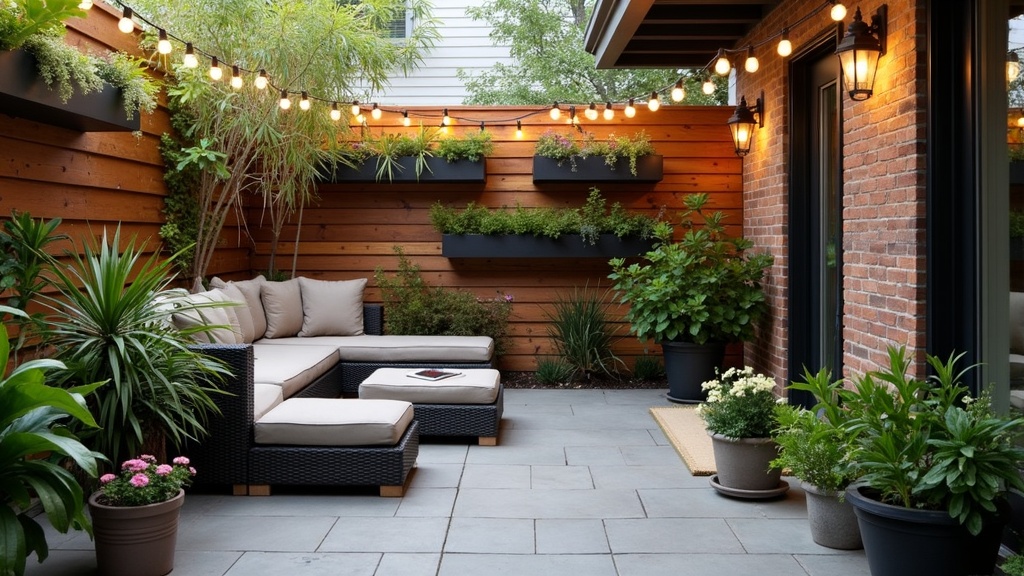
Key Facts for Maximising Small Outdoor Living Spaces
Before I get into the nitty-gritty, here are some really helpful facts about small space transformations:
Think Multi-Zone, Not Miniature
- Even a small patio packs more punch when you define different areas for lounging, eating, or gardening. Simple dividers like rugs or plant groupings work great.
Use Vertical and Overhead Space
- Fences, walls, pergolas, and hanging planters help maximise room for greenery and storage.
Choose Multifunctional and Flexible Furniture
- Foldout tables, stackable chairs, and benches with storage help keep things tidy and easy to rearrange.
Play Optical Tricks with Light and Layout
- Diagonal pathways, strategic mirrors, and light-colored finishes open up the space visually.
Add Height and Layers for Depth
- Raised beds, tiered planters, and sunken seating make the garden feel larger and more vibrant.
Use Lighting Strategically
- Well-placed lights extend the vibe after dark and visually stretch the boundaries.
Create a Focal Point
- Anchor your design with a single eye-catching feature like a bold plant or water bowl. It keeps the area from feeling cluttered.
Bring Indoor Comforts Outside
- Comfortable cushions, throws, and outdoor rugs boost cosiness so your garden feels like an extra living room.
Prioritise Pots and Portable Greenery
- Moveable containers and flexible plant arrangements offer a pop of life without eating up floor space.
Design for Function & Personality
- Add a personal touch like a bar cart, mini pond, or gallery wall of planters. Small outdoor areas shine when they reflect your style.

An example of how layered lighting can really transform a small outdoor living space.
Space Illusion Tricks: How to Make Small Gardens Look Bigger
It’s pretty wild how a few visual tweaks completely change the game in a tiny garden or patio. When I want a cramped space to feel airier, these are my go-to moves:
Use Diagonal or Curved Layouts
- Laying decking boards or patio stones on the diagonal draws the eye outward. I also like gentle curves in paths instead of rigid lines, as they soften the edges and add flow.
Reflect Light with Outdoor Mirrors
- Outdoor mirrors (secured safely!) bounce light around and reflect greenery, making it appear like there’s more “room” than there actually is.
Choose Light Colours for Walls and Furniture
- Pale walls, decks, and furniture reflect natural light instead of absorbing it, which keeps the vibe open and airy, especially in shaded spots.
Layer Planting Heights for Visual Depth
- Mixing plants at different heights, from ground cover to tall climbers, tricks the eye into seeing depth where there isn’t much square footage.
Divide Zones with Subtle Borders or Rugs
- A change in flooring texture, the placement of a rug, or a strategic row of potted plants can divide up the space and make each “zone” feel special (and the whole place bigger).
Smart Outdoor Design: Furniture, Zoning, and Clever Storage
Cramming less into a small space is usually smarter, but it’s also about being picky with what you choose. Here’s how I make sure every piece of furniture actually helps the area feel better, not busier:
How to Create Functional Outdoor Zones
“Zones” sound fancy but in real life it just means placing furniture or accents so you have a hangout area, a spot to eat, and maybe a tiny planting corner. Using a weather-safe rug for your dining nook or tucking a couple of lounge chairs in a corner instantly creates purpose. For very compact patios, you can define a zone simply by changing the orientation of your seating, or by using planters as gentle, movable dividers between two functions. Try to keep travel paths clear and accessible by arranging furniture close to walls or corners, letting you get the most from each available inch, whether you’re dining or just relaxing.
Space-Saving Furniture Ideas for Small Patios
- Look for benches with storage underneath, fold-down tables, or stackable chairs. It’s a huge help for tight balconies or porches.
- Furniture that does double duty, like a console table that also serves as a serving station for BBQ nights, saves tons of room.
- If space really is tiny, simple poufs or cubes work as both extra seating and a place to rest your feet. Ottomans that tuck under tables are also worth checking out.
- Think about nesting tables or stools—these tuck neatly away when not in use, providing surface area for drinks and snacks during gatherings, but they don’t clutter the space every day.
Using Vertical Storage and Wall-Mounted Planters
- Wall-mounted shelves, pegboards, or a row of hooks hold tools, lanterns, and even outdoor tableware, keeping everything easily reachable yet out of the way.
- Vertical planters, trellises, or ladder shelves packed with pots free up the ground, making cleaning and walking around easier. I’m a huge fan of upcycling old ladders as quirky plant displays. You can further maximise space by using hanging baskets hooked from pergola beams or sturdy wall brackets.
- Don’t forget overdoor storage options too. Small racks installed just outside the entrance work well for shoes or gardening gloves, and slim lockers or cabinets meant for outdoor use provide even more organisation without eating up valuable seating or plant areas.
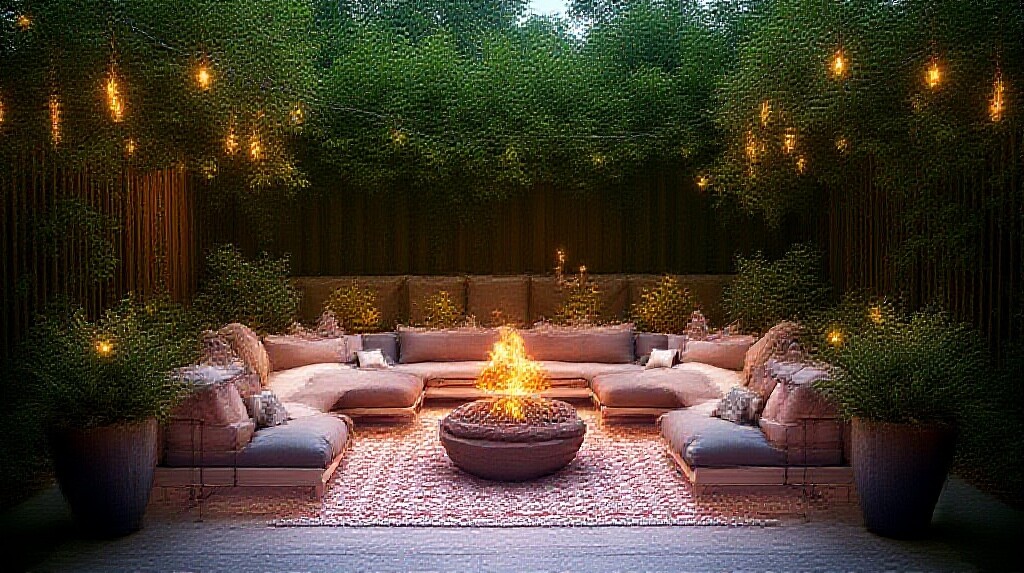
Lush Living: Plants, Layers, and Outdoor Personality
Getting some green in your space is pretty much non-negotiable if you want a cosy, inviting outdoor hangout. The trick is to go for variety and flexibility so you get the most impact even in a tiny area. Having a mix of leafy and flowering plants makes your small zone feel much fuller and more inviting.
How to Layer Plants for Height and Texture
Tiered, Raised, or Hanging
- Raised flower beds and stacked pots let you grow more without hogging all the floor room. Hanging baskets or wall planters add bursts of colour at eye level. If you’re up for DIY, consider creating your own tiered stands using reclaimed wood or crates, which can be painted to match your colour scheme and suit your vibe.
Best Climbing and Vertical Plants for Small Gardens
Go Vertical
- Climbing plants soften fences and give privacy. Clematis, jasmine, or even some veggie vines work well in containers and look great spilling over walls. Training vines upwards means you get more flowers and greenery without giving up precious ground space for other uses.
Portable Choices
- If you’re someone who likes a quick refresh, grouped pots let you swap out seasonal flowers or shuffle your setup whenever you feel like it. Try mixing different shapes and heights of containers to keep things visually interesting.
- Adding a large, leafy plant or small tree in one standout pot brings a lot of drama and can be used to create instant shade on sunny days—just roll it around as the sunlight moves across your space.
Add Personality with DIY Touches and Decor
Indoors Outside
- Plop down an outdoor rug, pile up pillows, or string up some fairy lights. It makes the whole place feel way more inviting.
Personal Touches
- DIY planters, a cute bar cart, or a tiny fountain bring individuality and fun. Even a budget solar light display or mini gallery wall of painted pots adds loads of charm. Hang a wind chime or quirky outdoor art to show some personality even if you’re short on real estate.
Create Wildlife-Friendly Features in Compact Gardens
- Even in the city, a bird bath or small bee-friendly flower pot boosts nature vibes and helps pollinators too. Worth checking out if you love watching little critters stop by. You can also give hedgehogs or butterflies a hand by including native plants and leaving a little wild corner if you have the space.
Transforming a Small Garden into a Cosy Outdoor Living Space
One of my clients had always dreamed of creating a cosy outdoor living space, but they felt unsure where to begin. Their garden was small, mostly grassed, with a few flowerbeds – and they worried it couldn’t be transformed into something beautiful or functional.
After some research and planning, we decided to focus on one neglected corner of the garden and turn it into a relaxing retreat. To maximise the space, we introduced comfortable seating layered with soft cushions and throws, added lush greenery, and incorporated mirrors and ambient lighting to create the illusion of depth and openness.
The finishing touch was a wooden pergola, draped with climbing plants and twinkling string lights, bringing warmth, height, and character to the area. The transformation was remarkable — a once-overlooked patch of lawn became a welcoming outdoor sanctuary, and the client was absolutely thrilled with the result.
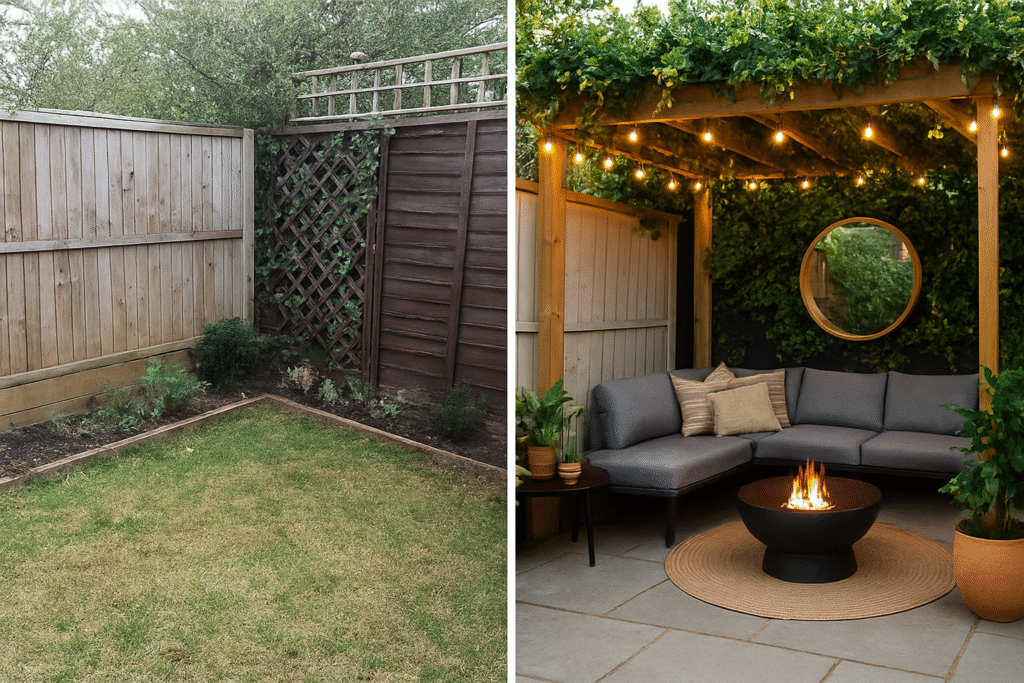
Expert Tips for Keeping Small Gardens Practical and Inspiring
Maintenance and Seasonal Care
- Staying tidy makes everything feel larger. Regularly trim plants, sweep surfaces, and keep furniture wiped down.
Choosing Colours to Enhance Space and Mood
- Go for lighter tones if your goal is that open feel. If you want things to feel cosier or more private, try some warm shades or deeper greens.
Keeping Layouts Flexible and Fresh
- Swapping out décor, switching furniture layouts, or changing up your planting scheme keeps things feeling fresh, even after years in the same space. Make small updates for each season—think new cushions in spring, or lanterns for autumn evenings.
Avoiding Overcrowding and Visual Clutter
- While it’s tempting to add lots of details, giving things room to breathe makes every element look its best. Keep a few focal points and let them shine instead of crowding every surface.
Also, invest in durable materials for cushions and rugs that can withstand the elements; this reduces the need for constant replacements and helps the space remain welcoming season after season. Add a few baskets or weatherproof bins for quick tidying, so stray toys or garden tools have a home out of sight when guests arrive.
Quick and Cost-Effective Upgrades for Small Outdoor Spaces
Affordable Lighting and DIY Decor Ideas
- Add string lights or solar lanterns for nighttime ambience; these make a dramatic difference without needing electrical work.
- Mix and match repurposed containers for an eclectic look that saves money and feels personal. Get creative with teapots, buckets, or even rain boots as planters.
Easy Vertical Gardening Projects
- DIY vertical plant walls from pallets or old shelves offer loads of planting space for next to nothing. Just secure them safely against a fence or wall.
Simple Paint and Repurposing Tricks
- A fresh coat of bright exterior paint on fences, pots, or old furniture picks up the mood instantly.
Portable Firepits and Cosy Finishing Touches
- Try a portable firepit or tabletop fireplace for extra warmth and ambience on cooler evenings. These are affordable and easy to move as needed.
- Hang an outdoor clock or weatherproof mirror to add depth and a touch of unique décor. Even small additions can shift the vibe without adding clutter.
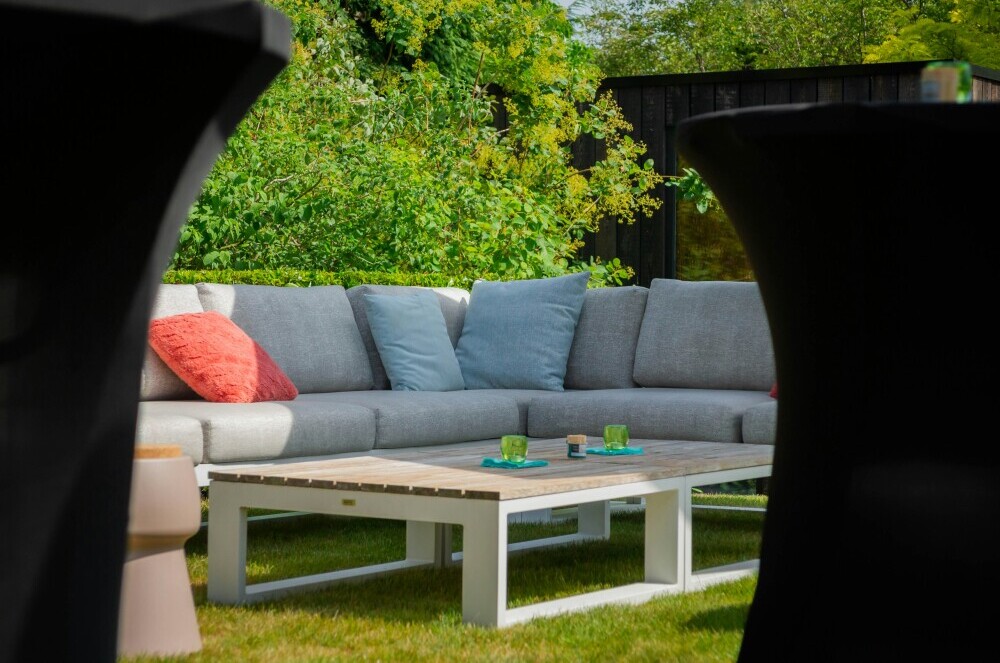
Still struggling with inspiration? Ideal Home have created an amazing article… “Small garden ideas – 35 brilliant ways to transform a tiny outdoor space.”
Top 10 Quick Wins for Small Gardens
Simple, budget-friendly upgrades that make a big impact in small outdoor spaces.
1. Add String or Solar Lighting
Create instant ambience and extend outdoor use after sunset.
2. Use Mirrors to Reflect Light and Space
Position mirrors safely to bounce natural light and visually double your garden area.
3. Refresh with a Coat of Paint
Brighten fences, walls, or furniture with light, reflective colours to open up the space.
4. Go Vertical with Planters or Trellises
Maximise greenery without losing floor space — perfect for herbs, flowers, or climbers.
5. Choose Multifunctional Furniture
Opt for benches with storage, foldable tables, or nesting stools to save room.
6. Add Cushions, Rugs, and Throws
Bring indoor comfort outside with weatherproof soft furnishings for a cosy feel.
7. Introduce a Small Focal Point
A fire pit, sculpture, or statement pot adds character and draws the eye.
8. Create Zones with Rugs or Planters
Define separate areas for dining, relaxing, or gardening to make the layout feel purposeful.
9. Mix Containers and Levels
Group pots of varying heights or add a raised bed for visual interest and layered greenery.
10. Include Wildlife-Friendly Touches
Hang a bird feeder, plant pollinator flowers, or add a mini pond to bring life and movement.
Frequently Asked Questions About Small Outdoor Living Spaces
People always ask how to get more out of their tiny outdoor spots. Here are my answers to the most common questions:
How Can I Make My Small Garden Look Bigger?
Answer: Rely on visual tricks—think diagonal paving, pale colours, mirrors, and good lighting. Use vertical elements for planting, and break up the space into small zones. Clear out unnecessary items so each corner can shine.
What Furniture Works Best in Compact Outdoor Areas?
Answer: Folding, stackable, or slimline furniture is the way to go. Benches with storage, hanging chairs, or pieces that double up (like tables with built-in planters) help keep the space useful and uncluttered.
How Can I Add Privacy Without Making It Feel Smaller?
Answer: Fast-growing climbers, bamboo screens, tall potted plants, or hanging outdoor drapes instantly add privacy. Shrubs in pots and decorative outdoor panels help block views without blocking light.
What Are the Most Affordable Small Garden Upgrades?
Answer: DIY planters, painted pots, solar or string lighting, and upcycled pallet furniture make an impact on a tight budget. Keep things modular and flexible so you can upgrade or swap details without needing a full makeover.
Final Thoughts: Designing Your Perfect Small Outdoor Retreat
Small outdoor spaces really can be whatever you want, with the right design psychology and smart choices. Multipurpose furniture, clever lighting, bold personality, and some thriving greenery create areas you’ll use way more often, even if it’s just a solo coffee in the morning sun. With these ideas in mind, you’re set to make your compact garden, patio, or balcony the best spot on your property.
Author Bio: My Journey Into Gardening & Outdoor Design
I grew up surrounded by the rural beauty of the Hampshire countryside, where my earliest dream was to work with animals. After finishing school, I studied at Sparsholt College and earned a National Diploma in Animal Management.
Life, as it often does, took me in a different direction. I built and ran another business, got married, and became a proud mum to three wonderful boys. After the birth of my youngest in 2020, I found myself at a crossroads, ready for a new career. Gardening—something that had always been a passion—was the natural choice.
I’ve now been working as a self-employed gardener in Hampshire for over five years, but my love for gardening began long before that. Growing up, I spent countless hours outside helping my parents, both keen gardeners (with three allotments!). Being outdoors, nurturing plants, and watching gardens transform with the seasons has always brought me joy.
While much of my knowledge has come through hands-on gardening experience, trial and error, and plenty of research, I’ve also relied heavily on trusted resources like the Royal Horticultural Society, which has guided me in becoming a confident, self-taught gardener.
Now, through Garden Nest Living, I want to share that journey and help others create outdoor spaces that grow with them. A garden doesn’t have to stop at the flowerbeds — it can extend into an inviting living area where you dine, relax, and celebrate the seasons as they unfold. With the right mix of planting, design, and comfort, your garden can become a year-round retreat that’s both beautiful and practical.
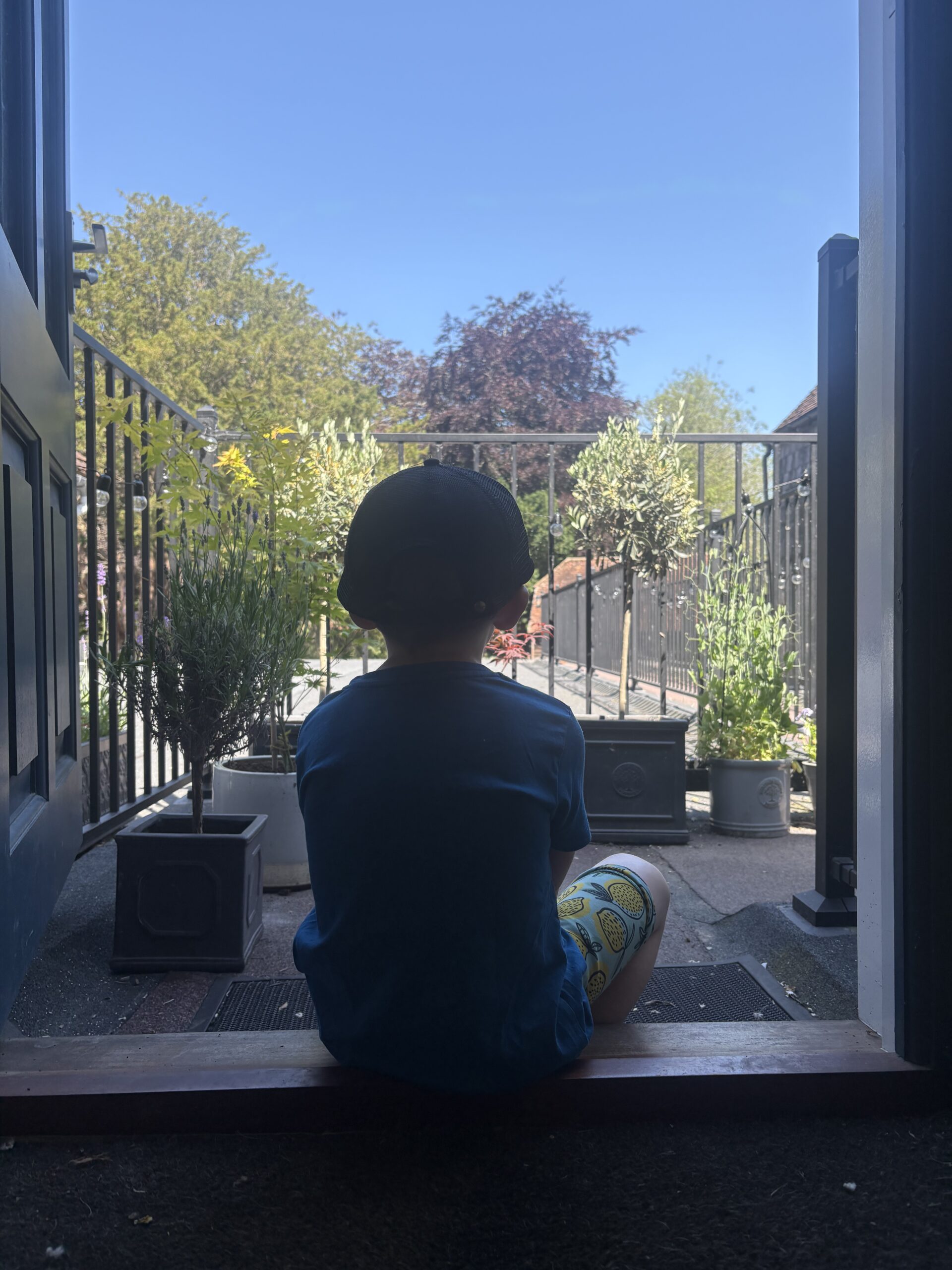
Our Son sitting on the doorstep, looking out at our roof garden and our back garden beyond.
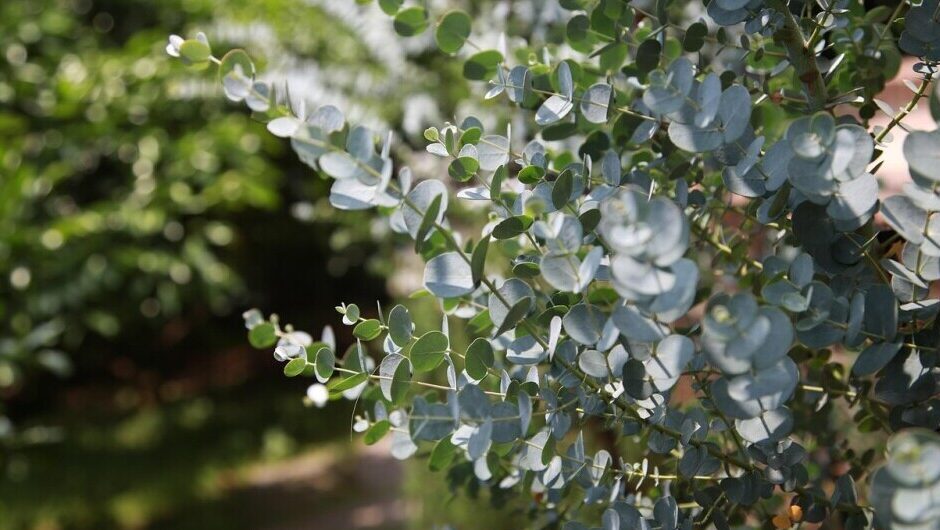
Great work on laying out the foundation for those of us that could use help creating the feel we want in our outdoor space.
This info is helpful for people who don’t have time or interest in heavy yard upkeep but still want a visually inviting outdoor zen type area.
Tips you provided such as working within your useable real estate and maximizing every inch by choosing either vertical planting, multifunctional furniture, layered lighting, plus zoning can make small spaces such as mine feel larger and more welcoming. For the more low-maintenance types, your guide points out some cool aspects of easy-care plants with portable purposeful use of furniture, and combining flexible layouts that require minimal effort to refresh or clean up.
It’s nice to have a space to unwind and relax – even though it’s just for a few months but can feel warm, personalized and a little bit polished without needing a gardener or large tools.
I have shaded areas in my backyard with half of it getting sunlight and aside from portable fireplaces what else can be done to create a tranquil feel during colder climates?
Thanks so much for your lovely comment — I’m so glad you found the tips useful! You’ve summed up the goal of this guide perfectly — creating a warm, inviting outdoor space that feels personal without needing constant upkeep or a full-time gardener.
For your shaded, cooler areas, think cosy textures and warm light — throws, cushions, lanterns, and fairy lights work wonders. Add a few evergreen plants or ferns for year-round greenery, and a tabletop fire bowl or fire pit for warmth.
Sounds like your garden is already halfway to being that perfect, tranquil hideaway!
It’s actually quite amazing when you see what you can do with a small space. I like your idea of having different zones, like one for eating and another for relaxing. You have made me think that I really need to try and transform our outdoor area into something more special that will make it more enticing to spend time in. At the moment it is very bland and boring.
I would also love to have a birdbath, but I am scared my cat will become too interested in this area.
Are there any types of plants to avoid when planning, like one that will irritate sensitive noses?
Thank you so much — I’m glad the post inspired you! It’s amazing how even a few thoughtful changes can make a small outdoor area feel like a real retreat. I completely understand your concern about the birdbath — it’s a lovely idea, but cats do make it a bit tricky! You might try placing the birdbath on a pedestal or in a slightly elevated, sheltered corner where your cat can’t easily reach it.
As for plants to avoid, that’s a great question. If you or anyone in your household has a sensitive nose, it’s best to steer clear of strongly scented varieties like jasmine or gardenia — their fragrance can be overwhelming in small spaces. Instead, opt for lighter-scented or neutral options such as lavender (which is gentle and calming), rosemary, or ornamental grasses. They add texture and interest without overpowering the air.